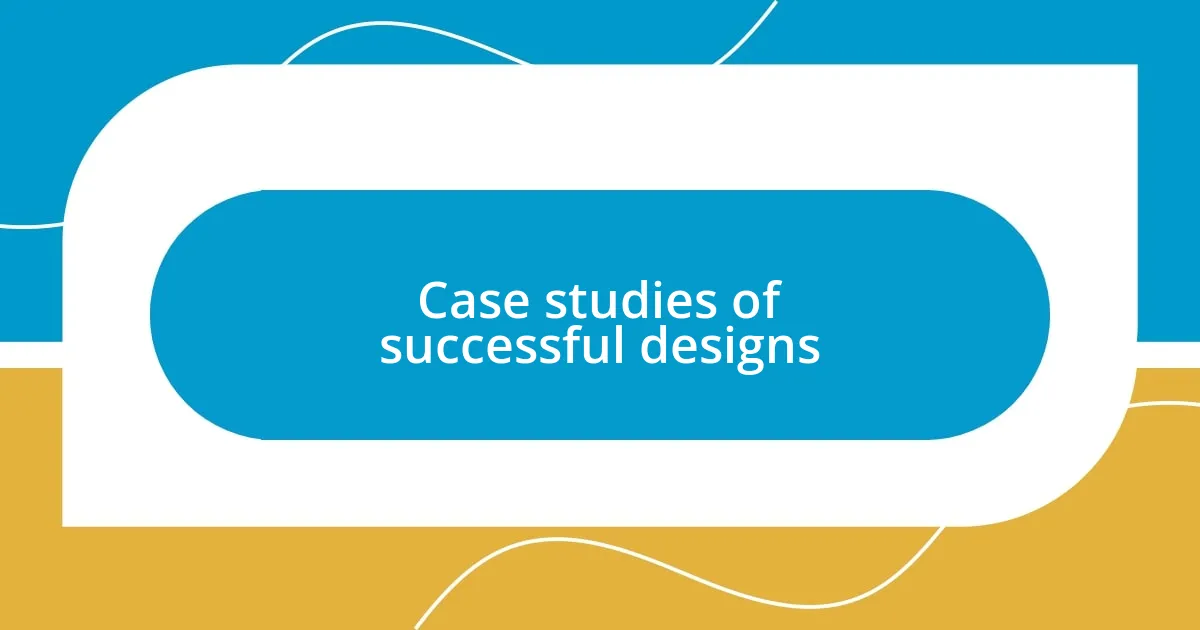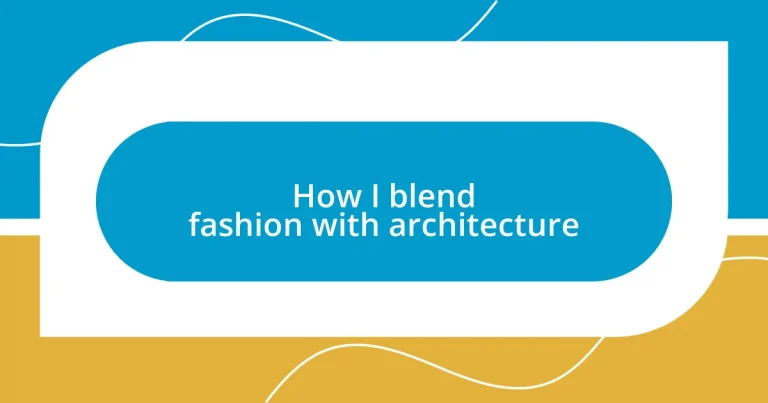Key takeaways:
- Fashion and architecture are interconnected through aesthetics, functionality, and cultural influences, often reflecting trends and societal changes.
- Key elements like materiality, form, and color in both fields create visual and emotional experiences, enhancing personal expression and identity.
- Collaborations, such as Zaha Hadid with Adidas and Prada’s Fondazione, exemplify the powerful synergy between fashion and architectural innovation.
- Exploring textures and sustainable materials in both disciplines fosters a meaningful dialogue about design consciousness and environmental relationships.

Understanding fashion and architecture
Fashion and architecture might seem like two distinct worlds, but they share a captivating dialogue rooted in aesthetics and functionality. I remember walking through a stunning cityscape filled with modern buildings, each designed with unique lines and textures, much like a designer crafting a garment. Have you ever noticed how the contours of a dress can mimic the curves of a well-constructed facade? It’s this interplay of form and purpose that creates a visual harmony I find incredibly inspiring.
As I explore the city, I often consider how both realms draw from cultural influences. There’s a fascinating rhythm in the way trends evolve in fashion, just as architectural styles shift with societal changes. I’ve watched fashion designers draw inspiration from specific movements, like Art Deco or Bauhaus, intertwining history with contemporary creativity. This connection makes me reflect on how a striking outfit can evoke the grandeur of a skyscraper, encouraging us to think about the stories behind the materials and designs we choose to embrace in our lives.
Moreover, both fashion and architecture invite us to explore identity and personal expression. When I slip into an outfit that resonates with my mood or aspirations, it mirrors the experience of walking into a space that feels like home. What about you? Have you felt that emotional connection when stepping into a beautifully designed room or donning a piece of clothing that just clicks? It’s this profound relationship between our environments and personal style that truly enriches our everyday experiences.

Key elements of architectural fashion
When I think about the key elements of architectural fashion, several aspects come to mind. These elements not only shape individual pieces but also guide the overall narrative of how fashion interprets structural ideas. For instance, I often find that materials play a pivotal role in both fields. The choice of fabric can evoke the strength of concrete or the delicacy of glass, allowing designers to create a visual and tactile experience that resonates with architectural principles.
- Materiality: The choice between natural fibers or synthetic blends can reflect the usage of raw stone versus steel, influencing aesthetics and durability.
- Form and Structure: Just as a building’s silhouette captures attention, a garment’s shape can express movement and identity.
- Color Palette: Colors can evoke emotions tied to different architectural styles, shaping the mood and personality of both spaces and outfits.
I remember attending a fashion show held in a minimalistic, industrial venue. The bold, angular silhouettes of the clothing seemed to echo the raw, unfinished concrete walls. It was as if each model was a living representation of the space itself, with the environment enhancing their ensembles. That night, I felt a captivating synergy between the fabric and architecture, leaving me contemplating how these key elements intertwine and harmonize each other in ways that are both uplifting and profound.

Case studies of successful designs
Case studies of successful designs reveal the incredible potential when fashion and architecture converge. One project that springs to mind is the collaboration between designer Zaha Hadid and fashion brand Adidas. Hadid’s architectural philosophy, marked by fluidity and bold forms, translated beautifully into the iconic sneaker designs. I remember trying on a pair of those sneakers and feeling like I was walking in a piece of art, showcasing how functional fashion can blur into architectural elegance.
Another fascinating example is Prada’s Fondazione in Milan, a structure that embodies the marriage of high fashion and architectural innovation. The space itself feels like a grand runway, where every angle invites exploration. It was during my visit that I truly experienced a visceral connection; the juxtaposition of contemporary creativity against historical context left me in awe. Have you ever found yourself in a place that made you appreciate design on a deeper level? It’s those moments that highlight how architecture can elevate fashion, creating an environment that allows both to shine.
Finally, I can’t overlook the influence of fashion exhibitions in iconic venues like the Met. The Costume Institute’s displays often reflect architectural grandeur and serve as a canvas for storytelling through fabric. I vividly remember standing in that iconic hall, surrounded by fashion history, and feeling the energy flow between the designs and their spatial context. It’s these case studies that reinforce my belief in the powerful synergy of fashion and architecture, able to create experiences that resonate long after we leave.
| Project | Designers | Key Elements |
|---|---|---|
| Zaha Hadid + Adidas Sneakers | Zaha Hadid, Adidas | Fluidity, Bold Forms |
| Prada Fondazione, Milan | Prada, OMA | Contemporary vs. Historical |
| The Met Costume Institute | The Costume Institute | Exhibition Architecture |

Exploring textures and materials
Exploring the tactile aspects of both fashion and architecture fascinates me. For example, think about the difference between a structured wool coat and a flowing silk dress. The coat’s rugged texture can remind one of a sturdy brick façade, offering warmth and resilience, while the silk evokes the ethereal nature of architectural glass, inviting a play of light and reflection. How does it feel to wrap yourself in a material that not only defines a piece of clothing but also resonates with the essence of a space?
When I attended an architectural exhibition recently, I couldn’t help but admire the way various materials were showcased. The juxtaposition of smooth marble against rough timber caught my eye. It struck me how similar sensations occur in fashion; consider a jacket lined with soft fleece but finished with a textured leather exterior. This interplay of textures brings pieces to life, much like how varying materials in a building create a dynamic visual experience. Have you ever felt drawn to a fabric simply because of its texture? It’s amazing how a single touch can evoke a rush of emotions or memories.
Additionally, the innovative use of sustainable materials in both architecture and fashion is something that truly excites me. When I discovered a clothing line that utilized recycled fabrics, I instantly thought of structures built with reclaimed wood or repurposed bricks. This approach not only enhances aesthetics but also tells a powerful story about our relationship with the environment. It’s fascinating to consider how sustainability can act as a unifying thread between our garments and the places we inhabit, doesn’t it? Embracing these shared values in both disciplines encourages a meaningful dialogue about consciousness in design.












